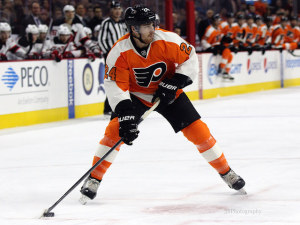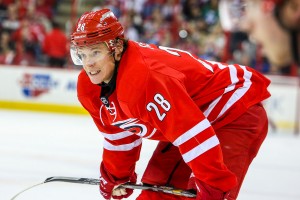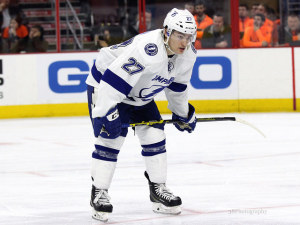In 2013-14, it was the Toronto Maple Leafs. In 2014-15, it was the Colorado Avalanche. Everyone in the advanced stats community screamed that these teams were headed towards regression after enjoying strong seasons prior despite poor underlying numbers. Sure enough, both regressed to non-playoff team status.
This year, there are no shortage of candidates to see the same regression occur next season. In come cases, a bounceback year should be expected. For others, expectations should be tempered for next season. Remember, regression is movement towards the mean, both from below and above.
5. Matt Read, Flyers

In his first 3 years in Philadelphia, Read established himself as a strong two-way forward with good speed and some scoring touch.He regularly played on a shutdown line with Sean Couturier, taking the toughest defensive assignments on the team.
Despite that, he scored 38 even strength goals from 2011-12 to 2013-14, 38th in the NHL and only three behind Claude Giroux, and one behind Jake Voracek in that time.
This year, Read saw a significant drop in his shooting percentage from a career average of 15.1% to 5.6%. Much of the problem was due to a high ankle sprain that he played through for 2 months during the season. The injury limited his speed, one of his best assets, and his effectiveness plummeted. Unsurprisingly, the Flyers PK suffered greatly as Read was one of its key contributors in past years.
With a healthy ankle and a return to his career shooting percentage, expect a bounceback season for Read in 2015-16.

4. Alexander Semin, Hurricanes
For years, Semin has been regarded as one of the best snipers in the NHL. He possesses a rocket of a wrist shot, shooting at a 13% clip for his career. However, he’s been regarded as an enigmatic player throughout his career whose effort has come into question a few times.
This production, he saw his production fall off a cliff to a career worst .33 PPG.
He failed to reach double digits in goals for the first time in his career, and shot at a career worst 6.5%. It’s possible that age is starting to catch up to him as he is in his 30s now, but he should still have something left in the tank.
One part of the problem is that Semin’s goalies saved a career low 88% of their shots faced at 5-on-5. That certainly didn’t help to endear him to the coaching staff, despite 5-on-5 save percentage being something filled with variance that forwards have no control over.
If his goalies save more shots when he’s on the ice, he’ll likely receive more ice time and confidence from the coaching staff, leading to a possible return to his sniper ways.
3. Jonathan Drouin, Lightning

While Drouin’s best assets are his vision and passing ability, he is still a deadly goalscorer with the puck on his stick. But over 70 NHL games this season, he shot a paltry 5.3%.
In his career in the QMJHL, he was a 16.4% shooter. His shooting percentage in the NHL should settle somewhere in the middle, around the NHL average of 9%.
Part of the problem was that Drouin was playing with a rather poor set of linemates this season in terms of offensive talent. Defenses could key on him, and he was not getting high quality opportunities. He also was not shooting the puck nearly enough, registering only 1.08 shots per game.
With better linemates and a higher volume of shots, expect the goals to come for Drouin next year.
2. Nick Foligno, Blue Jackets
At the improbable age of 27, Nick Foligno enjoyed a career high in goals (31), assists (42), and points (73) this season. He shot at a sizzling 17%, which was a hefty 5.7% above his career average of 11.3%.
It’s incredibly unlikely for a guy to break out at the age of 27 years old after playing 8 seasons in the NHL prior, so it’s likely that this won’t be sustainable for Foligno. Among Columbus players with at least 40 games, Foligno had the highest PDO at 1021, indicating a regression may be on the way.
Playing extensively with Ryan Johansen was also a big boon to Foligno’s point totals. If he’s taken away from Johansen, expect his point totals to drop even more.
1. The Calgary Flames
The Flames are 2014-15’s version of the Maple Leafs and Avalanche. This season, they posted the third worst Corsi-For percentage in the league, but were able to make the playoffs and actually win a series, something neither the Leafs or Avs could do.
They had the fourth highest team PDO in the league this year, an indicator of luck. However, they lack the strong underlying possession numbers that the teams ahead of them possessed (NYR, MTL, & TB).
They finished 7th in the league in goals, but 28th in shots. In the top 35 of shooting percentage this season (minimum 100 shots), there are four Flames. Their deadly top line of Johnny Gaudreau, Sean Monahan, and Jiri Hudler, and center Lance Bouma. They shot a combined 16.5%.
It’s possible the dropoff may not be that large, as that group was shooting a career 13.5% coming into this season, but that’s an extremely small sample size for four players, with Jiri Hudler accounting for 801 of those 1,059 shots. A much larger sample size is needed to believe the others can sustain anything near that number.
People have been predicting the regression since the Flames’ hot start, but it hasn’t shown its face yet. We shall see if Bob Hartley and his hard working group can repeat their success next season.